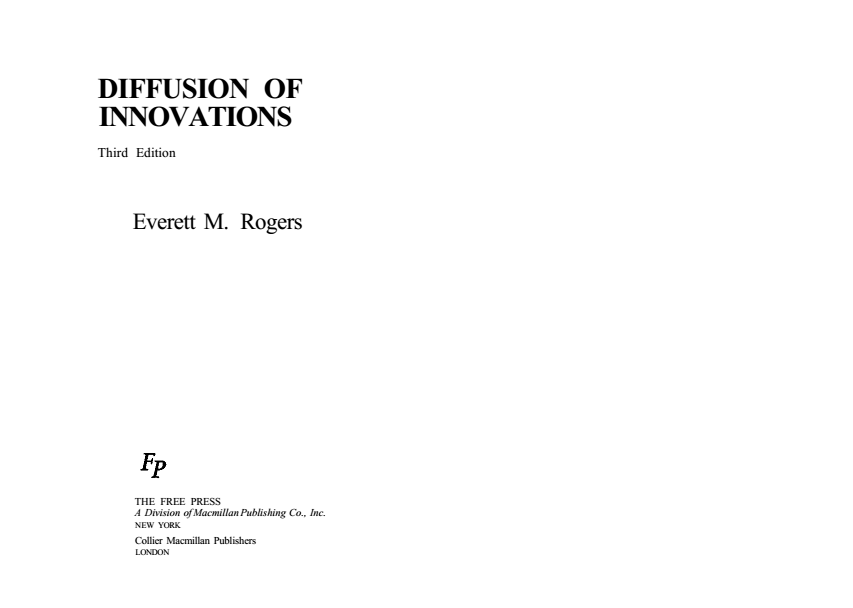
Diffusion of Innovations (3rd ed.)
Diffusion of Innovations (3rd ed.)
Contents
List of Case Illustrations xiii
Preface xv
Chapter 1 ELEMENTS OF DIFFUSION 1
WHAT IS DIFFUSION? 5
FOUR MAIN ELEMENTS IN THE DIFFUSION
OF INNOVATIONS 10
1.The Innovation 11
2. Communication Channels 17
3. Time 20
4. A Social System 24
SUMMARY34
Chapter 2 A HISTORY OFDIFFUSION RESEARCH .... 38
THE BEGINNINGS OF DIFFUSION RESEARCH
IN EUROPE 40
Gabriel Tarde and The Laws of Imitation 40
The British and German-Austrian Diffusionists 41
THE RISE OF DIFFUSION RESEARCH TRADITIONS. 42
Paradigms and Invisible Colleges 43
The Anthropology Research Tradition 46
Early Sociology50
Rural Sociology57
Education 62
Public Health and Medical Sociology 65
Communication 72
Marketing 74
Geography 77
General Sociology 78
V
vi
Chapter 3
Contents
A TYPOLOGY OF DIFFUSION RESEARCH 79
SUMMARY 85
CONTRIBUTIONS AND CRITICISMS OF
DIFFUSION RESEARCH 87
THE CONTRIBUTIONS AND STATUS OF
DIFFUSION RESEARCH TODAY
CRITICISMS OF DIFFUSION RESEARCH 91
The Pro-Innovation Bias of Diffusion Research....
The Individual-Blame Bias in Diffusion Research
The Recall Problem in Diffusion Research
The Issue of Equality in the Diffusion of Innovations
GENERALIZING ABOUT DIFFUSION VIA
META-RESEARCH
Relating Theory and Research at the Middle Range
The Oversimplification of Two-Concept Generalizations.
The Reliability of Diffusion Generalizations
92
103
112
118
126
128
130
131
SUMMARY 133
Chapter 4 THE GENERATION OF INNOVATIONS . . . 134
THE INNOVATION-DEVELOPMENT PROCESS 135
1. Recognizing a Problem or Need 135
2. Basic and Applied Research 138
3. Development 139
4. Commercialization 143
5. Diffusion and Adoption 144
6. Consequences 149
SOCIOECONOMIC STATUS, EQUALITY, AND
INNOVATION DEVELOPMENT 153
TRACING THE INNOVATION-DEVELOPMENT
PROCESS 155
Shortcomings of the Tracer Studies 157
Questions for Future Research 157
CONVERTING RESEARCH INTO PRACTICE 158
The Agricultural Extension Model 159
Decentralized Diffusion Systems 160
SUMMARY 161
Contents
Chapter 5 THE INNOVATION-DECISION PROCESS 163
A MODEL OF THE INNOVATION-DECISION
PROCESS 163
KNOWLEDGE STAGE 164
Which Comes First, Needs or Awareness
of an Innovation ? 164
Types of Knowledge about an Innovation 167
Early Versus Late Knowers of Innovations 168
PERSUASION STAGE 169
DECISION STAGE 172
IMPLEMENTATION STAGE 174
The End of Implementation 175
Re-Invention 175
CONFIRMATION STAGE 184
Dissonance 185
Discontinuance 186
ARE THERE STAGES IN THEPROCESS? 191
Evidence of the Stages 192
Variance and Process Research 194
COMMUNICATION CHANNELS BY STAGES
IN THE INNOVATION-DECISION PROCESS 197
Categorizing Communication Channels 197
Mass Media Versus Interpersonal Channels 198
Cosmopolite Versus Localite Channels 200
COMMUNICATIONCHANNELS BY ADOPTER
CATEGORIES 201
THE INNOVATION-DECISION PERIOD 202
Rate of Awareness-Knowledge and Rate of Adoption 202
Length of the Period by Adopter Category 203
SUMMARY 206
Chapter 6 ATTRIBUTES OF INNOVATIONS AND
THEIR RATE OFADOPTION 210
ATTRIBUTES OF INNOVATIONS 211
RELATIVE ADVANTAGE 213
Economic factors and Rate of Adoption 214
Status Aspects of Innovations 215
viii Contents
Relative Advantage and Rate of Adoption 217
Effects of Incentives 219
COMPATIBILITY 223
Compatibility with Values and Beliefs 223
Compatibility with Previously Introduced Ideas 224
Compatibility with Needs 225
Compatibility and Rate of Adoption 226
Technology Clusters 226
Naming an Innovation 227
Positioning an Innovation 228
COMPLEXITY 230
TRIALABILITY 231
OBSERVABILITY 232
EXPLAINING RATE OF ADOPTION 232
THE DIFFUSION EFFECT 234
OVERADOPTION 236
SUMMARY 238
Chapter1INNOVATIVENESS AND ADOPTER
CATEGORIES 241
CLASSIFYING ADOPTER CATEGORIES ON THE
BASIS OF INNOVATIVENESS 242
The S-Curve of Adoption and Normality 243
The Method of Adopter Categorization 245
ADOPTER CATEGORIES AS IDEAL TYPES 247
Innovators: Venturesome 248
Early Adopters: Respectable 248
Early Majority: Deliberate 249
Late Majority: Skeptical 249
Laggards: Traditional 250
CHARACTERISTICS OFADOPTER CATEGORIES.... 251
Socioeconomic Characteristics 251
.Personality Variables 257
Communication Behavior 258
A Summary of the Characteristics of
Adopter Categories 259
The Innovativeness-Needs Paradox 263
PREDICTING INNOVATIVENESS WITH
MULTIPLE CORRELATION TECHNIQUES . 265
Contents
COMPUTER SIMULATION OF INNOVATION
DIFFUSION 267
SUMMARY 268
Chapter 8 OPINION LEADERSHIP AND
DIFFUSION NETWORKS 271
MODELS OFMASS-COMMUNICATION FLOWS 272
Hypodermic Needle Model 272
The Two-Step Flow Model 272
HOMOPHILY-HETEROPHILY AND THE FLOW OF
COMMUNICATION 274
Homophily-Heterophily 274
Homophily as a Barrier to Diffusion 275
MEASURING OPINION LEADERSHIP AND
NETWORK LINKS 277
CHARACTERISTICS OF OPINION LEADERS 281
External Communication 282
Accessibility 282
Socioeconomic Status 282
Innovativeness 284
Innovativeness, Opinion Leadership, and
System Norms 284
MONOMORPHIC AND POLYMORPHIC OPINION
LEADERSHIP 288
DIFFUSION NETWORKS 293
Communication Network Analysis 294
The-Strength-of- Weak-Ties 295
Who Is Linked to Whom in Networks? 299
SOCIAL LEARNING THEORY 304
Contrasting Social Learning and Diffusion 305
Horizons for Social Modeling 307
SUMMARY 307
Chapter 9 THE CHANGE AGENT 312
CHANGE AGENTS AS LINKERS 313
THE SEQUENCE OF CHANGE AGENT ROLES 315
Contents
FACTORS IN CHANGE AGENT SUCCESS 317
Change Agent Effort 317
Change Agency Versus Client Orientation 318
Compatibility with Clients' Needs 319
Change Agent Empathy327
HOMOPHILY AND CHANGE AGENT CONTACT .... 321
Change Agent Contact with Lower-Status Clients 323
Paraprofessional Aides 325
Change Agent Credibility 328
InauthenlicProfessionalization of Aides 331
OPINION LEADERS 331
CLIENTS' EVALUATIVE ABILITY 332
CENTRALIZED AND DECENTRALIZED
DIFFUSION SYSTEMS 333
The Classical Diffusion Model 333
Comparing Centralized Versus Decentralized
Diffusion Systems 334
Advantages and Disadvantages of Decentralized
Diffusion 337
SUMMARY 343
Chapter 10 INNOVATION IN ORGANIZATIONS 347
ORGANIZATIONS 348
ORGANIZATIONAL INNOVATIVENESS 355
Shortcomings of Organizational Innovativeness
Studies 356
Size and Organizational Innovativeness 358
Structural Characteristics and Organizational
Innovativeness 359
STAGES IN THE INNOVATION PROCESS IN
ORGANIZATIONS 361
A Model of the Innovation Process in Organizations 362
Time Sequence of the Stages in the Innovation Process.... 365
SUMMARY 370
Chapter 11 CONSEQUENCES OF INNOVATIONS 371
A MODEL FOR STUDYING CONSEQUENCES 375
WHY HAVEN'T CONSEQUENCES BEEN
STUDIED MORE? 375
Contents
CLASSIFICATIONS OF CONSEQUENCES 379
Desirable Versus Undesirable Consequences 380
Direct Versus Indirect Consequences 384
Anticipated Versus Unanticipated Consequences 387
EQUALITY IN THE CONSEQUENCES
OF INNOVATIONS 391
The Issue of Equality in Development Programs 392
The Communication Effects Gap and
the Consequences of Diffusion 394
Gap-Widening Consequences of the Adoption
of Innovations 398
Social Structure and the Equality of Consequences 401
Strategies for Narrowing Gaps 403
Wider Gaps Are Not Inevitable 408
SUMMARY AND CONCLUSIONS 410
Bibliography 414
Name Index 441
Subject Index 447
 Cart
Cart  Checkout
Checkout